#hashable
Explore tagged Tumblr posts
Text

Don’t miss the chance to hang out with @novafarmsretail and scoop up some @hashables This Saturday the 1st from 3pm – 6pm Can’t wait to see you there! #hashables #novafarmsretail #CommAveCanna #cannabis #dispensary #edibles #brookline #familyowned #events #hashinfused #solventless #commavecanna https://bit.ly/4c1dbZX
0 notes
Text
Dictionaries and Structuring Data in Python
A Python Dictionaries are a fundamental data structure in Python that allows you to store and manage data in a key-value pair format and easily write very efficient code. In many other languages, this data structure is called a hash table because its keys are hashable.. A python dictionary is a collection of key : value pairs. This powerful and flexible data type is crucial for efficient data manipulation and organization. We'll understand in a bit what this means.
Introduction to Dictionaries
Decorators are a powerful feature in Python that allow you to modify the behavior of a function or a class method. They are often used to add "wrapping" functionality, such as logging, access control, memoization, and more. In this deep dive, we'll explore what decorators are, how they work, and provide. Decorators are a versatile and powerful feature in Python that allow you to modify the behavior of functions and methods. They are widely used for various purposes, including logging, access control, performance monitoring, and more. Understanding how to create and apply decorators can greatly enhance your ability to write clean, reusable, and maintainable code
Dictionaries vs. Lists in python
Dictionaries and Lists are different fundamental data structures in Python. Each with its own unique characteristics and use cases collections of items, whereas the dictionary is an unordered collection of data in a key whereas Lists are ordered collections of items: value pair form. Both lists and dictionaries are mutable, you can add, edit, delete, or modify the elements understanding the differences between them are crucial for effective programming and data management.
Key Differences Between Dictionary List and in Python
Dictionary List
Unordered collection of key-value pairs Ordered collection of elements
Elements are accessed by their key Elements are accessed by their index
Defined using curly braces{} Defined using square brackets[].
Checking Whether a Key or Value Exists in a Dictionary
Python, dictionaries are used to store key-value pairs, and it’s often necessary to check for the presence of a specific key or value within a dictionary. Here’s how you can perform these checks effectively Recall from the previous that the in and not in operators can check whether a value exists in a list.You can also use these operators to see whether a certain key or value exists in a dictionary.
Enter the following into the interactive shell.
1. Existence Checking for Key
To check if a key exists in a dictionary, you can use the in keyword. This method is efficient and commonly used.
2. Checking for the Existence of a Value
To check if a value exists in a dictionary, you can use the in keyword with the values() method of the dictionary. This will iterate through the values and check for the presence of the specified value.
3. Using Get ()Method to Check for a Key
The get() method can be used to check for the existence of a key and return a default value if the key does not exist. This method is useful if you want to avoid raising an exception when the key is not found.
4. Checking for the Existence of a Key with Exception Handling
You can use a try-except block to check for the existence of a key. This approach is less efficient than using the in keyword but can be useful in scenarios where you prefer exception handling.
By using these methods, you can efficiently check for the presence of keys and values in a dictionary, making your code more robust and error-free.
0 notes
Text
Week 355
Happy Thursday! The much-expected Apple event has been announced for next Tuesday, where we’ll likely see the new iPhones. In Swift news, two new packages have been released, Swift Atomics and Swift Algorithms. Swift Atomics can help developers work easier with atomic operations in Swift, while Swift Algorithms adds specific methods to collection types, useful for, among others, generating permutations or combinations, random sampling, removing duplicate elements, etc.
Another thing worth mentioning, the App Store Connect app for iOS has been updated with TestFlight integration. Yes, it is now possible to manage TestFlight builds from your iPhone or iPad 🎉
Marius Constantinescu
Articles
Lazy stacks secrets, by @zntfdr
The Modern Ways to Reload Your Table and Collection View Cells, by @Lee_Kah_Seng
Do protocols break Single Responsibility Principle?, by @dmtopolog
A (Business Hat) Case Against Adopting SwiftUI Today, by @jasonalexzurita
Reduce boilerplate code with an automatic synthesis of Equatable and Hashable conformance, by @sarunw
Formatting Notes and Gotchas, by @AndyIbanezK
Testing networking logic in Swift, by @johnsundell
Understanding the differences between your Core Data model and managed objects, by @donnywals
Videos
Building Augmented Reality experiences with iOS, by @roxanajula
Credits
zntfdr, LeeKahSeng, DmIvanov, jasonzurita, sarunw
1 note
·
View note
Video
youtube
Interesting Topics of Modern Python Programming - Using Python Dictionaries. What are Hashable as well as immutable and mutable objects. In this video I've explained multiple topics in context of creating and using Python dictionary because they form the building blocks of python dictionary like the concept of hashable, mapping, built in immutable and mutable objects.
1 note
·
View note
Text
Extending a collection where the element is a custom defined type
Arrays, sets, and dictionaries are three primary collection types in Swift. If we would like to extend a collection where the element is a custom defined type. Generally, a type which is able to conform a certain protocol is necessary.
First, have a protocol be hashable For example, have a protocol be hashable first since the custom type will be stored as an element of a collection.
protocol CustomProtocol: Hashable { var string: String { get } }
Declare a custom defined type Here, let's declare a sturct as an example. Please also noted that other custom defined classes or enums are able to have similiar implementation.
struct CustomStruct: CustomProtocol { let string: String var hashValue: Int { get { return string.hashValue } } static func ==(lhs: CustomStruct, rhs: CustomStruct) -> Bool { return lhs.string == rhs.string } }
Then, create a function in Set extension with constraints specified by a where clause for CustomProtocol
extension Set where Element: CustomProtocol { func getFirstElement(equalTo string: String) -> Element? { return filter({$0.string == string}).first } }
Finally, let's do a test and see its result
// Example let set: Set = [ CustomStruct(string: "Watermelon"), CustomStruct(string: "Orange"), CustomStruct(string: "Banana") ] let output = set.getFirstElement(equalTo: "Orange") print(output)
In my playground with Xcode 8, I can get Optional(CustomStruct(string: "Orange")) in log console.
Create a function in Set extension for CustomStruct only For certain consideration, If create a function in Set extension for CustomStruct only is needed, just change little bit for where clause.
extension Set where Element == CustomStruct { func getFirstElement(equalTo string: String) -> Element? { return filter({$0.string == string}).first } }
0 notes
Text
Intro to Dictionaries in Python
A Dictionary in Python is another data container type in Python, just like an integer, string, list, etc. In other languages, this concept is also known as hash tables.
A dictionary consists of keys and their values, an example is;
cylinderAttributes = { ’radius’ : 2, ‘height’ : 4 }
Here, the keys are radius and height, and their corresponding values are 2 and 4. The dictionary name is cylinderAttributes. Keys also do not have to be of the same type.
Dictionaries are a table of immutable (not changeable) hashable objects/keys. For more info on hash tables and hash functions, check out this video https://www.youtube.com/watch?v=KyUTuwz_b7Q
The items in a dictionary have no order like a set or list would do, and thus slicing is not possible. To use a dictionary, you would use it like a list, except without using an index (like list[0]), you would use the hashable object known as a key. Using the previous dictionary as example, you would use cylinderAttributes[’radius’] to print 2.
The keys in a dictionary are immutable (unable to change), however, the values stored in association with each key are mutable (able to change). This is used as an advantage to set values. If you wanted to change the radius value in the example, you could do it like this: cylinderAttributes[’radius’] = 5. This would set the radius key to store 5.
A good analogy to use to describe dictionaries is occupants to house addresses. The occupants may change throughout time, but the house address will always be the same (unless the house gets burnt down, but we don’t talk about that).
Because Python is so great, you can create new keys on the fly even after you’ve created a dictionary. However, if you try to access a key that has not been created or set, you will get a KeyError. This means that querying a key will stop your execution of code, which kinda sucks. To counter this, dictionaries provide a setdefault() method, which allows a non-existing key to be added to the dictionary, and setting a value of None to it so it doesn’t halt any execution. You can supply a parameter to this method, to allow for a default value other than None.
For example, cylinderAttributes.setdefault(10, volume) would create a key called ‘volume’, and print the value 10.
cyldinferAttributes.setdeault(10, radius) however would print the correct value of 5, as the setdefault is meant to add any new key and not reset a key value.
Here are some useful dictionary operators:
key in d ==> True if key is in d
key not in d ==> True if key is not in d
len(d) ==> length of dictionary
d[key] ==>Value of corresponding key
d.keys() ==> List of all keys in dictionary
d.setdefault(key) ==> Value corresponding to key if it exists, otherwise None. (If there is a value provided before the key, then that will be the default value instead of None).
2 notes
·
View notes
Text
python syntax cheat sheet working 0T0&
💾 ►►► DOWNLOAD FILE 🔥🔥🔥🔥🔥 int() → 15 truncate decimal part float("e8") → round(,1)→ rounding to 1 decimal (0 decimal → integer number). It's easy to learn and fun, and its syntax is simple yet elegant. Python is a popular choice for beginners, yet still powerful enough to to back some of the. Python CheatSheet. Basic syntax from the python programming language. Showing Output To User. The print function is used to display or print output. Basic rules to write Python syntax: Rule #1: Python is white-space dependent; code blocks are indented using spaces. Rule #2: Python language. 9 Work fast with our official CLI. Learn more. If nothing happens, download GitHub Desktop and try again. If nothing happens, download Xcode and try again. There was a problem preparing your codespace, please try again. Each abstract base class specifies a set of virtual subclasses. These classes are then recognized by isinstance and issubclass as subclasses of the ABC, although they are really not. ABC can also manually decide whether or not a specific class is its virtual subclass, usually based on which methods the class has implemented. Splat expands a collection into positional arguments, while splatty-splat expands a dictionary into keyword arguments. Splat combines zero or more positional arguments into a tuple, while splatty-splat combines zero or more keyword arguments into a dictionary. If variable is being assigned to anywhere in the scope, it is regarded as a local variable, unless it is declared as a 'global' or a 'nonlocal'. Decorator that prints function's name every time the function is called. Decorator that caches function's return values. All function's arguments must be hashable. A decorator that accepts arguments and returns a normal decorator that accepts a function. MRO determines the order in which parent classes are traversed when searching for a method or an attribute:. Decorator that automatically generates init , repr and eq special methods. Mechanism that restricts objects to attributes listed in 'slots' and significantly reduces their memory footprint. A duck type is an implicit type that prescribes a set of special methods. Any object that has those methods defined is considered a member of that duck type. Unlike listdir , scandir returns DirEntry objects that cache isfile, isdir and on Windows also stat information, thus significantly increasing the performance of code that requires it. A server-less database engine that stores each database into a separate file. Values are not actually saved in this example because 'conn. Bytes object is an immutable sequence of single bytes. Mutable version is called bytearray. List that can only hold numbers of a predefined type. Available types and their minimum sizes in bytes are listed above. Sizes and byte order are always determined by the system. A thread-safe list with efficient appends and pops from either side. Pronounced "deck". Type is the root class. If only passed an object it returns its type class. Otherwise it creates a new class. Right before a class is created it checks if it has the 'metaclass' attribute defined. If not, it recursively checks if any of his parents has it defined and eventually comes to type. Exception description, stack trace and values of variables are appended automatically. Array manipulation mini-language. It can run up to one hundred times faster than the equivalent Python code. Object that groups together rows of a dataframe based on the value of the passed column. Skip to content. Star Comprehensive Python Cheatsheet gto This commit does not belong to any branch on this repository, and may belong to a fork outside of the repository. Branches Tags. Could not load branches. Could not load tags. Launching Xcode If nothing happens, download Xcode and try again. Launching Visual Studio Code Your codespace will open once ready. Latest commit. Git stats 2, commits. Failed to load latest commit information. Oct 2, View code. Use a capital letter for unsigned type. If array shapes differ in length, left-pad the shorter shape with ones: 2. If any dimensions differ in size, expand the ones that have size 1 by duplicating their elements: 3. If neither non-matching dimension has size 1, raise an error. Example For each point returns index of its nearest point [0. Contents 1. Also works on strings. Also works on dictionary and set. Replaces ones with matching keys. Accepts floats. Indices can be None. Fraction yes yes yes yes float yes yes yes complex yes yes decimal. Also group 0. London without DST. Also gettz. Raises ValueError. Could be too late to start deleting vars. Do not mix. Joins two or more pathname components. Also Path '. Also Path. Permissions are in octal. Returns its stdout pipe. Returns None on success. Also ':memory:'. Exits the block with commit or rollback. A multithreaded and non-lazy map. Starts a thread and returns its Future object. Full exception if full. Empty exception if empty. Also locals. BeautifulSoup html , 'html. ConnectionError : print "You've got problems with connection. Last point gets connected to the first. Draw frame draw. Rect , , 20 , 20 while all event. QUIT for event in pg. Rect x , y , width , height Floats get truncated into ints. Allows assignments. Surface width , height New RGB surface. Format depends on source. Pass None for default. BytesIO urllib. Clock while all event. Also plt. Sr is treated as a row. Uses 'left' by default. Use l. A Series is c. Also updates b 3 4 5 items that contain NaN. Func can return DF, Sr or el. All operations return a Sr. Text "What's your name? Input ], [ sg. About Comprehensive Python Cheatsheet gto Contributors You signed in with another tab or window. Reload to refresh your session. You signed out in another tab or window.
1 note
·
View note
Text
python – Check if two unordered lists are equal
Python has a built-in datatype for an unordered collection of (hashable) things, called a set. If you convert both lists to sets, the comparison will be unordered.
0 notes
Text
Creating Dictionaries
A dictionary is an unordered set of key: value pairs. It gives us a way to map pieces of data to each other so we can quickly find values associated with one another.

Dictionaries begin and end with curly braces { } Each item consisters of a key and a value. Each key: value pair is seperated by a comma.
Keys can be strings and numbers but CANNOT be lists or dictionaries ( If you try you will get a TypeError). Values can be any type, including a string, a number, a list, or another dictionary.

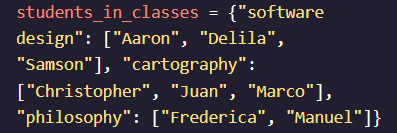
You can also mix and match key and value types.

Unhashable means that the list is an object that can be changed. Dictionaries in Python rely on each key haveing a hash value, which is specific identifier for the key. If the key can change then the hash value would not be reliable. Keys must always be unchangable, hashable data types, like numbers or strings.

A dictionary doesn’t have to contain anything. Sometimes we need to create an empty dictionary when we plan to fill it out later.

To add a single key: value pair to a dictionary:

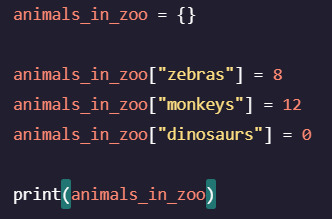
.update() - add multiple key: value pairs to a dictionary at once

Adding a key uses the syntax list[key] = value but this syntax can also be used to overwrite the existing value attached to a key.
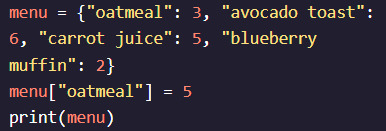
yields

If we have two lists that we want to combine into a dictionary:

You can create a dictionary using a dict comprehension using this syntax:

REMEMBER that zip() combines two lists into an iterator of tuples with the list elements paired together.
This dict comprehension:
1) takes a pair from the iterator of tuples
2) names the elements in the pair key and value
3) creates a key: value in the students dictionary
4) repeats steps 1-3 for the entire iterator of pairs

0 notes
Text

Learn more at Comm Ave Canna #Hashables #Dispensary #Brookline #FamilyOwned #commavecanna https://bit.ly/4b5aOp6
0 notes
Text
Portable Quickhash GUI is an open source, cross-platform utility for hashing various types of data, including files, entire file folder trees, physical disks, logical disk volumes, file compares, and more. The interface is precise and clearly marked making it quite useful for any skill level, it includes the ability to hash via MD5, SHA1, SHA256, SHA512 and xxHash hash algorithms. Allows recursive hash, or hash and copy to reconstructed directory and new hash to destination directory, simple recursive hash of all files in a selected directory and its subdirectories along with physical disk hashability in Windows and both physical. and logical disks if running on Linux (using root or sudo), for example /dev/hda or /dev/hda1. Portable Quickhash GUI enables computer security or digital forensics personnel to efficiently hash files when files have been extracted from forensic software before or after transport to non-forensic personnel. It worked quickly during testing, providing almost instant results and appears to be faster than other tools we've worked with in the past. It supports drag and drop of individual files to make it even faster. All generated results can be quickly exported to a CSV text file, HTML web file or clipboard. XP/Vista/7/8/8.1/10English5.26MB
0 notes
Text
i know and understand why, but still i always forget lists aren’t hashable types so i have to cast the stupid thing to a tuple first. so dumb just remember it
1 note
·
View note
Text
Python immutable / hashable set & dict
Python builtin set & dict are mutable, thus cannot be used as dict keys.
However, there is an immutable version set: frozenset
For immutable dict, try python3 MappingProxyType. Refer to this introduction: How to Make an Immutable Dict in Python
However, although MappingProxyType is immutable, it's not hashable. A general way to make dict hashtable, is to convert the value to tuple of key-value pairs:
class hashabledict(dict):
def __hash__(self):
return hash(tuple(sorted(self.items())))
Refer to StackOverflow: Python hashable dicts
Some leetcode probloems are about looking for anagrams, like 49. Group Anagrams. An obvious solution is to compare the a dict of char counters, theoretically this is the best solution. However for the test dataset of this leetcode no. 49 probloem, string length is no more than 100, comparing the sorted string would be 50% faster.

0 notes
Text
DICTIONARIES
(6.00.1X)
Dictionaries store pairs of data:
--keys:
• must be unique
• immutable type (int, float, string, tuple,bool)
• actually need an object that is hashable, but think of as immutable as all immutable types are hashable
• careful with float type as a key
no order to keys or values! d = {4:{1:0}, (1,3):"twelve", 'const':[3.14,2.7,8.44]}
--values:
• any type (immutable and mutable)
• can be duplicates
• dictionary values can be lists, even other dictionaries!
We can create dictionaries:
-- my_dict = {} -- this is an empty dictionary'
-- grades = {'Ana':'B', 'John':'A+', 'Denise':'A', 'Katy':'A'} --ex of a dict...
**add an entry: grades['Sylvan'] = 'A'
**test if key in dictionary: 'John' in grades returns True
'Daniel' in grades returns False
**delete entry: del(grades['Ana'])
**get an iterable that acts like a tuple of all keys(no guaranteed order) :
grades.keys() returns ['Denise','Katy','John','Ana']
grades.values() returns ['A', 'A', 'A+', 'B']
CREATING A DICTIONARY
def lyrics_to_frequencies(lyrics):
myDict = {}
for word in lyrics:
if word in myDict:
myDict[word] += 1
else:
myDict[word] = 1
return myDict
USING THE DICTIONARY
def most_common_words(freqs):
values = freqs.values()
best = max(values)
words = [ ]
for k in freqs:
if freqs[k] == best:
words.append(k)
return (words, best)
LEVERAGING DICTIONARY PROPERTIES
def words_often(freqs, minTimes):
result = []
done = False
while not done:
temp = most_common_words(freqs)
if temp[1] >= minTimes:
result.append(temp)
for w in temp[0]:
del(freqs[w])
else:
done = True
return result
print(words_often(beatles, 5))
FIBONACCI WITH A DICTIONARY
def fib_efficient(n, d):
if n in d:
return d[n]
else:
ans = fib_efficient(n-1, d) + fib_efficient(n-2, d)
d[n] = ans
return ans
d = {1:1, 2:2}
print(fib_efficient(6, d))
GLOBAL VARIABLES
can be dangerous to use
◦ breaks the scoping of variables by function call
◦ allows for side effects of changing variable values in ways that affect other computation
but can be convenient when want to keep track of information inside a function
example – measuring how often fib and fib_efficient are called
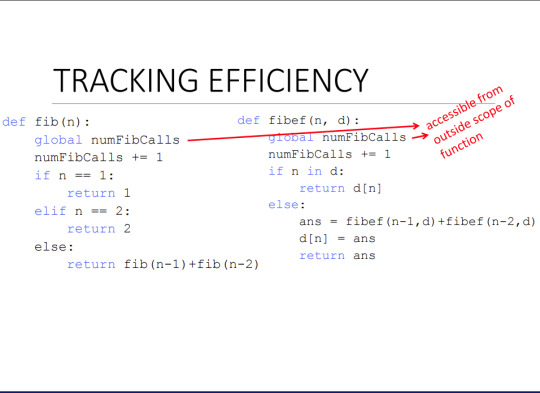
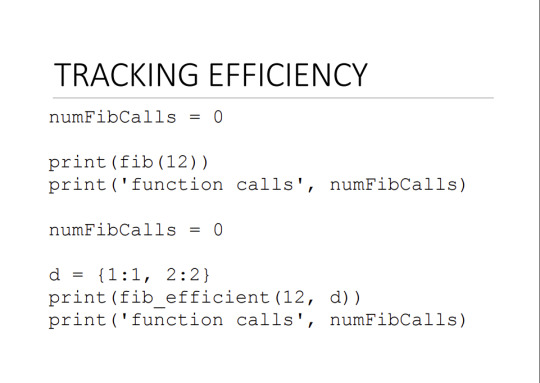
0 notes
Text
Python / Counter
Python / Counter, seguimos con las colecciones de python y hoy veremos uno muy particular, espero les sea util!
Bienvenidos sean a este post, hoy hablaremos sobre este funcion del modulo de colecciones. Este tipo de dato es una sub clase de diccionario (dict) y nos permitira almacenar la cantidad de elementos que son “hashables”, para entender el concepto veamos un ejemplo: >>> from collections import Counter >>> print(Counter(['B','B','A','B','C','A','B','B','A','C'])) Counter({'B': 5, 'A': 3, 'C':…

View On WordPress
0 notes
Text
Counter() collection in python:
Counter() collection in python: The Python Counter is a subclass of dictionary object which helps to count hashable objects. It is used to keep the count of the items in an iterable in the form of an unordered dictionary where the key represents the item.
The Python Counter is a subclass of dictionary object which helps to count hashable objects. It is used to keep the count of the items in an iterable in the form of an unordered dictionary where the key represents the item in the iterable and the value represents the count of that element in the iterable. The Counter holds the data in an unordered collectionCounter() count the items in an…
View On WordPress
0 notes